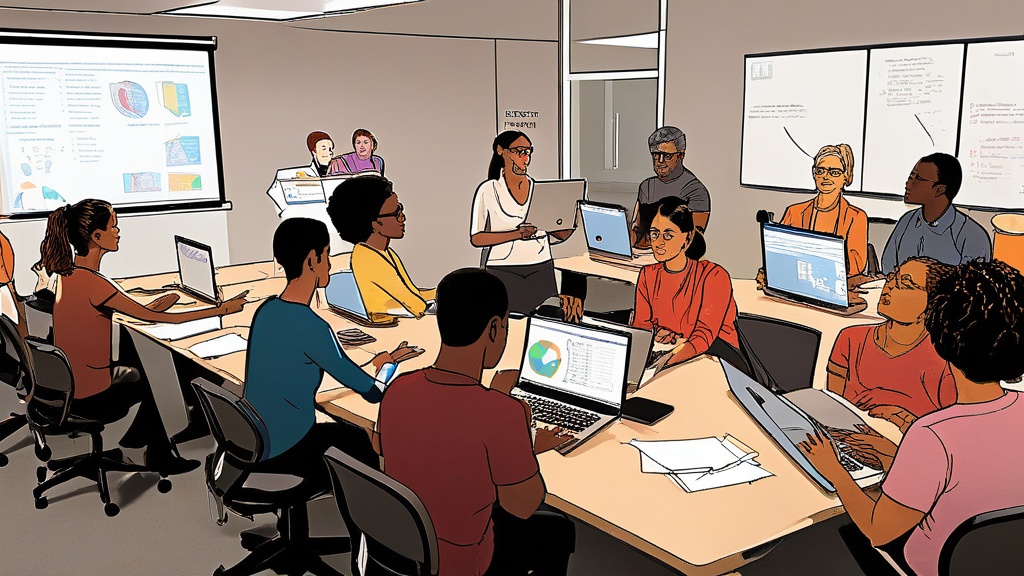Let me say this first. I’ve been doing this “trainning” thing for a long time. Yes, I see the typo. No, I’m not fixing it. Long story. In my world, people call it training, coaching, upskilling, onboarding, skill-building, whatever helps the budget get approved. I care about one thing: do people actually learn? Do they remember? Can they do the task on a Tuesday when the Wi‑Fi is moody? That’s the game. And it’s messier than the shiny slide decks suggest. I’ve always found that real learning needs practice, feedback, simple tools, and a reason to care. Fancy words help nobody when the printer jams.
Why most programs flop (and how I learned the hard way)

My first year as a trainer, I thought slides would save me. I built a 120-slide deck with animations. It was gorgeous. People clapped. They also forgot everything by Friday. I learned this the fun way—by watching error reports explode like popcorn. Not cute.
In my experience, most workshops fail for three boring reasons:
- No clear behavior change. Lots of “awareness.” Zero action.
- No practice with real tools. Role-play is fine, but try the actual system, please.
- No follow-up. We treat learning like a one-day party, not a habit.
What I think is simple: if you can’t answer “what should someone do differently after this?” then you’re just entertaining them with snacks. And maybe a survey.
The three phases I never skip
Before: prep people to win
I don’t start a session cold. I send a tiny pre-task. A two-minute video. A one-page SOP. A screenshot of the form we’ll use. If they can’t touch the tool early, the workshop becomes a magic show. And not the good kind.
I also set one goal. One behavior. Example: “After this, you can file a ticket in under 3 minutes with all fields right.” Clear. Testable. Not “understand the ticketing platform.” Nobody wakes up and “understands.”
During: practice beats talk
Short demos. Then reps. I like a 5/15 rhythm: 5 minutes demo, 15 minutes practice. People learn by doing. Even soft skills like feedback and conflict need drills. Yes, actual scripts. Yes, you will feel weird. That’s fine. First pancake is always ugly.
After: tiny nudges and real measurement
Follow-up is where learning sticks. I send a two-sentence reminder every week for a month. I create a quick checklist. I build a dashboard that counts behavior, not feelings. Surveys are nice. Behavior is better.
The tools are not magic. But I still use them.
Let me list a few, and how they help me not lose my mind.
- LMS (learning management system): store stuff, track stuff. Won’t fix boring content.
- Microlearning: 2–5 minute chunks. Good for reminders. Not great for deep skills.
- Job aids: checklists, one-pagers, cheat sheets. My best friend. People love quick wins.
- Simulators/sandboxes: safe place to mess up. Pain now, safety later.
- Mentorship: a human who cares. Old school. Still undefeated.
If you want a classic overview of what “training” even is, the dry but solid stuff is here: training overview. It’s fine. Just don’t fall asleep.
People problems beat content problems every time
I used to think the content was the problem. It’s not. People are. They’re busy. Tired. Stressed. Smart. Distracted. Real life wins. So I stop fighting it. I design around it.
- Make tasks small. 10-minute blocks. Micro goals.
- Use plain language. If you need a glossary to read your course, you’ve lost.
- Give feedback fast. I like live coaches. Also peer review. Quick and kind.
- Make the value obvious. “Do this, save 20 minutes.” Not “because policy says so.”
- Remove friction. Fewer clicks. Shorter forms. Better templates.
I also build in habit triggers. For example, a calendar nudge at 9:55 a.m. every Day 2 after onboarding: “Run the daily checklist. Takes 5 minutes.” People do it because it’s easy, and it’s on time.
Metrics that don’t lie (much)
I like simple numbers that connect to work. Time on task. Errors per 100 tickets. First-call resolution. Safety incidents. Output. You want signals that management cares about anyway. Not “engagement color wheels.”
| Metric | Why I Use It | How to Measure Fast | Common Trap |
|---|---|---|---|
| Time to Proficiency | Shows speed of learning | Days from start to first solo task | Counting attendance as progress |
| Error Rate | Quality, not vibes | Errors per 100 tasks | Hiding errors to look good |
| Retention After 30/60/90 | Checks if it sticks | Short re-tests, shadow audits | Testing trivia, not behavior |
| Manager Check-ins | Coaching is the glue | # of 10-min reviews logged | Checkbox coaching with no feedback |
My short recipe for building a program in one week
You want a playbook? Fine. Here’s mine. It’s not perfect. It works.
Day 1: Pick one behavior
Meet the team lead. Ask three questions: What’s breaking? What does good look like? How will we know it worked?
Day 2: Build the job aid first
One page. Step by step. Screenshots help. Print it. If it fits on one page, you’re focused.
Day 3: Make a 20-minute practice loop
Demo for 5 minutes. Practice for 15. Use real cases. Fake data is fine, but real shapes. People should sweat a little. Not cry.
Day 4: Coach managers
Give them a 10-minute guide for the next four weeks. They are the real trainers. I just set the stage.
Day 5: Launch small
Pilot with five people. Measure. Fix the worst parts. Ship it next week wider. Don’t wait six months to be perfect.
Formats I use and why
| Format | Time | Cost | Good For | Pitfall |
|---|---|---|---|---|
| Live Workshop | 2–4 hours | Medium | Kickoff, energy, team norms | Too much talk, not enough reps |
| Microlearning Video | 2–5 minutes | Low | Reminders, one tip at a time | Becomes noise if too many |
| Simulation | 30–60 minutes | High | Complex skills, safety, systems | Setup takes time |
| Peer Coaching | 15 minutes weekly | Low | Soft skills, culture, retention | Dies without structure |
| Apprenticeship | 3–12 months | Medium–High | Skilled trades, long-term roles | Needs strong mentors |
Compliance, certifications, and that one confusing form
I don’t love paperwork. I do love guardrails. If you need to set up a real pathway—like apprenticeships—this site helps: Apprenticeship.gov. It’s practical. Real templates. And if you want the policy side, the iceberg under the water, you can browse the U.S. workforce programs here: Employment and Training Administration. Not exciting. Useful.
The “why” behind it all (and the joke about slides)
I love the moment when someone does the task and says, “Wait. That’s it?” Yes. That’s the point. Simple beats fancy. My job isn’t to impress. It’s to make your Tuesday boring and smooth. No drama. No scrambling for a password while a customer stares.
By the way, I’ve seen 200-slide decks about “communication.” Let me save you time. If your team needs to talk better, have them practice saying hard things with a script. Then swap. Then repeat. It’s not deep philosophy. It’s reps.
A few tiny rules I live by
- Teach what people will use in the next week. Not someday.
- Never run a session without a job aid. Ever.
- Shorten everything. Then shorten again.
- When in doubt, get a manager to model the task live. People copy bosses.
- End every session with “What will you do in the next 24 hours?” Make them say it out loud.
Jargon, acronyms, and the “SNM” moment
I once had a learner drop “SNM” in a chat, and half the class just nodded like they understood. They didn’t. This happens a lot. If you’re curious about what SNM means in text, that breakdown is pretty good. Point is, never assume the room speaks the same language. Define terms. Put them on a slide. Then use them in a sentence.
Soft skills are learned like any other skill
We talk about soft skills like they’re magic. They’re not. You can drill them. Example: feedback.
- Write a one-minute script: “What I saw… impact… next step.”
- Say it to a partner. Record on phone. Watch back. Cringe. Fix.
- Do three reps a week. That’s it. You’ll get better fast.
Same with conflict. Same with asking questions. Same with listening. Teach, practice, repeat. This is not TED Talk land. This is gym time.
Digital skills? Keep the clicks low.
E-learning can help. I use it all the time. But the best digital training is click-light and task-heavy. If your course makes people click “Next” 47 times, it’s not a course. It’s a hostage situation.
I build tasks like: “Upload a file, tag it, share with your lead, and paste link here.” That tells me they can do the job. Screenshots help. Short videos help. No fluff.
When the stakes are high
If you’re in healthcare, aviation, manufacturing, or safety work, simulations and checklists save lives. I mean that. Follow the script. Practice until it’s boring. Then practice again. Fast hands come from slow, careful reps.
Global notes and future trends

Skills change fast. AI is everywhere. People worry. I get it. The fix is not panic courses. It’s steady upskilling. Short, regular learning. Real tasks. If you want to nerd out on global skill trends, this site is solid: OECD skills. For TVET folks, the UNESCO hub is decent too: UNEVOC. Don’t let reports paralyze you. Just pick one skill and start.
Pet peeves from a decade in the room
- Calling everything “transformation.” Sometimes it’s a new form. Relax.
- Rushing onboarding. Then acting shocked when people fail.
- Teaching theory for an hour before the first click. Please, don’t.
- Zero feedback. Then a surprise performance review. Not helpful.
- Confusing busy work with learning. Quizzes on definitions don’t change behavior.
Two stories I keep replaying
The forklift class that wasn’t
We had a safety course that felt like a podcast. Great voice. Nice slides. Guess what? Minor accidents kept happening. We added a simple drill: three runs in a marked zone, timed, with a coach. Accidents dropped. It wasn’t the speech. It was the reps.
The call center “soft skills” fix
Average handle time was high. Managers wanted “empathy training.” We ran two drills: mirroring and labeling (yes, from negotiation land), three reps each, every shift for two weeks. Handle time went down 12%. Customer scores rose. People felt better. Not because of magic words. Because they practiced.
Budget talk (the not-fun part)
I hate budget fights. But I do them. My tip: tie every line item to a business number. “We need a sandbox” becomes “we need a sandbox to lower error rates by 30% in 90 days.” If someone won’t fund tools, show a short pilot. Small wins get money. Big promises get eyebrows.
Self-paced vs. live: pick on purpose
When I choose self-paced, it’s because the skill is stable and simple. When I choose live, it’s because we need trust, feedback, or speed. Blends work best. A quick self-paced primer. A short live drill. A 30-day follow-up. That mix wins more than either alone.
Oh, and about the spelling
I know I wrote “trainning” earlier. Twice even? Maybe more. I’ve seen worse in real documents. The truth is, spelling doesn’t make the skill. Doing does. Still, I’ll try to keep my typos to a hobby, not a lifestyle.
Quick map for teams just starting
- Pick one skill tied to a number you care about.
- Write a one-page job aid. Print it.
- Design a 20-minute practice loop. Reps, not lectures.
- Coach managers to run weekly 10-minute check-ins.
- Track one metric. Improve it. Then pick the next skill.
Real talk about motivation
Some days, people won’t care. That’s fine. Make the task short. Reduce friction. Celebrate small wins. And add peer pressure, the gentle kind. A scoreboard helps. Not to shame. To nudge.
Stuff I wish someone told me year one
- If the room is quiet, ask less. Do a demo. Then ask one thing.
- Silence isn’t boredom. It’s thinking. Give it five full seconds.
- Snacks matter. Hydrated people learn better. This is science. Probably.
- Don’t chase perfect. Ship a small thing. Fix it next week.
Little glossary I hand out on day one
- Job aid: the cheat sheet you’ll actually use.
- Sandbox: a safe copy of the real system where you can mess up.
- Role-play: pretend chat or call to practice words and tone.
- Assessment: a way to check if you can do the thing, not just say you can.
- Feedback loop: you do it, someone watches, you get tips, you try again.
One last nudge
Look, if you remember nothing else, remember this: practice + feedback + follow-up. That trio beats any long speech. And if you’re still reading, thanks for hanging out in my corner of the internet. I’ll keep sharing what works and what doesn’t.
Oh, and I promised I wouldn’t debate spelling again. So here goes one last time: I run “trainning” sessions all week. Happy now? Good. Let’s get back to work.
FAQs
- Do I need long courses, or can I just do short lessons? Short lessons work great if you add practice and follow-up. Long courses without reps don’t stick.
- How do I get my team to actually do the exercises? Make them tiny, track one metric, and have managers model the behavior. Also, snacks.
- What’s the best way to measure if training worked? Pick a work metric (time, errors, quality) and watch it for 30/60/90 days. Behavior beats surveys.
- How do I teach soft skills without it being awkward? Use scripts, do quick role-plays, record and review. Three reps a week for two weeks. Awkward fades.
- Where can I learn about official programs or apprenticeships? Check out Apprenticeship.gov for guides and the ETA site for policy and programs.

Hey, I’m Lucas. My blog explores the patterns and connects the dots between tech, business, and gaming. If you’re a curious mind who loves to see how different worlds intersect, you’re in the right place.




Love the emphasis on practice and follow-up. Real learning needs action, not just awareness. Great insights!
Love the emphasis on practice and follow-up! Learning is a process, not a one-time event. Fabulous insights.
Real learning comes from practice, feedback, and follow-up. It’s all about behavior change!
Learning should be practical, not just theoretical. Practice, feedback, and follow-up are key for real retention and growth.
How do you ensure that training programs lead to actual behavior changes?